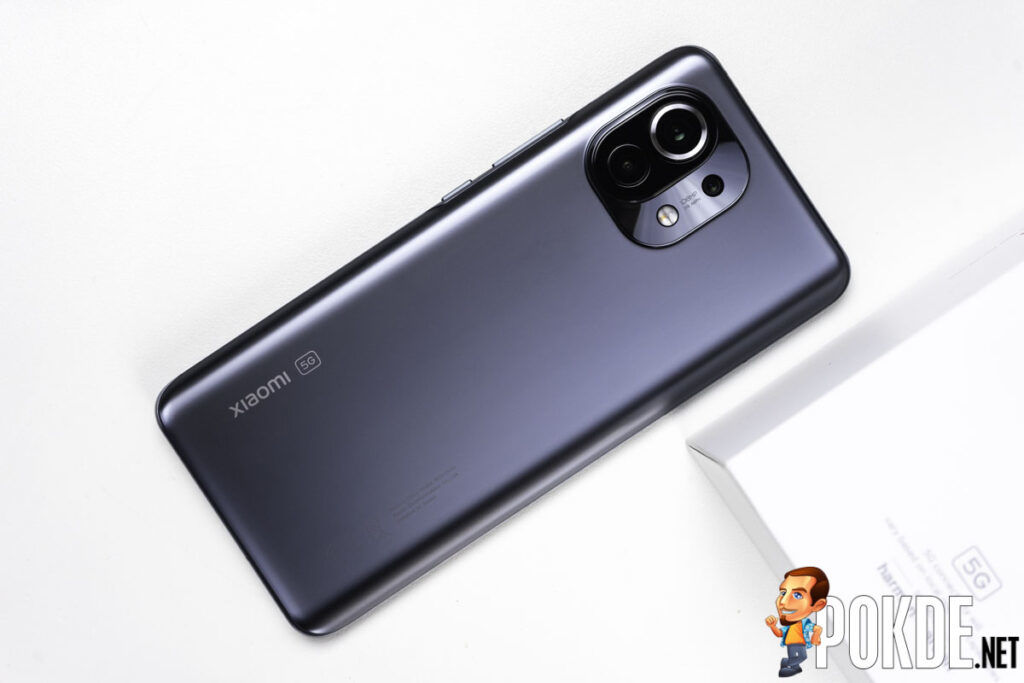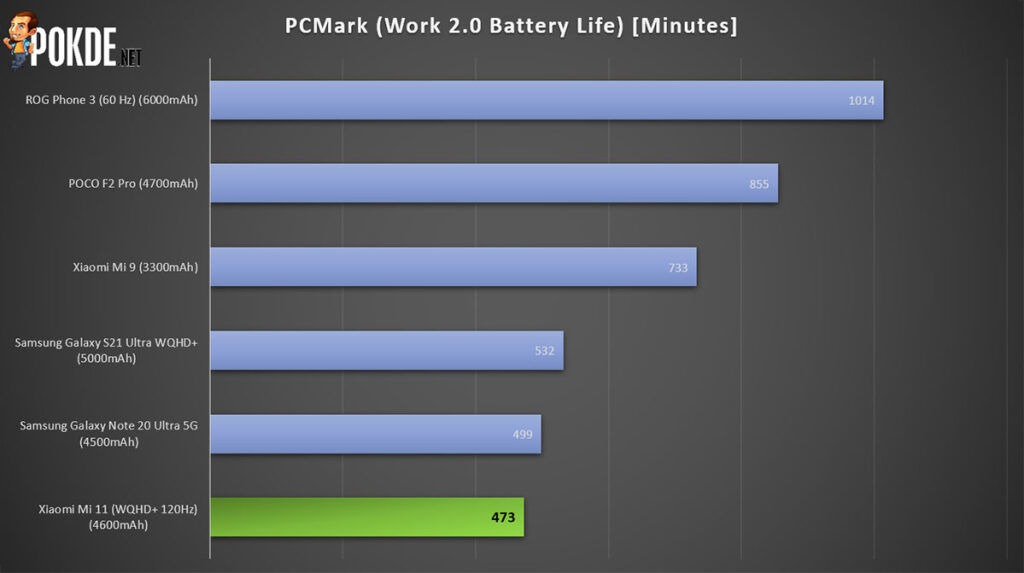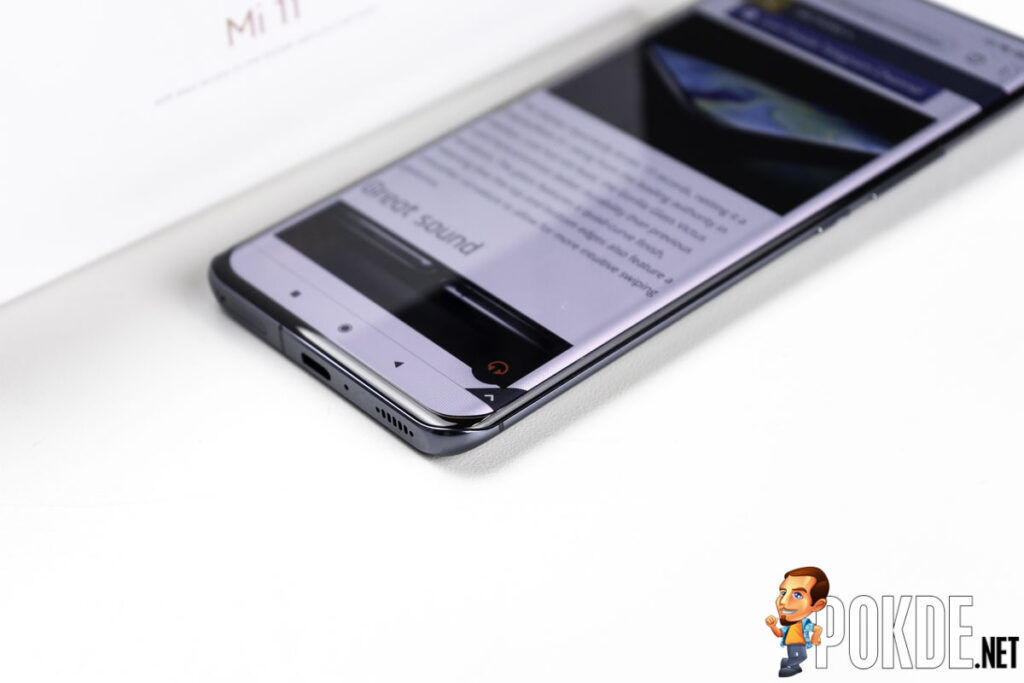Xiaomi Mi 11 Review — inching ever closer to perfection
-
Appearance - 9/10
9/10
-
Efficiency - 7.5/10
7.5/10
-
Features - 8.6/10
8.6/10
-
Materials - 9/10
9/10
-
Performance - 8.6/10
8.6/10
-
Portability - 8.5/10
8.5/10
-
User Experience - 8/10
8/10
-
Value - 8.5/10
8.5/10
Summary
The Xiaomi Mi 11 is indisputably Xiaomi’s best flagship yet, with it coming so close to perfection except for two rather major drawbacks.
Overall
8.5/10Pros
+ Comes with 55W charger in the box!
+ Smooth curves all around the device feels great to hold
+ Unique camera hump looks awesome
+ Snapdragon 888 is a really powerful chipset
+ The 120Hz WQHD+ OLED display here is one of the best displays in a smartphone
+ harman/kardon stereo speakers are phenomenal
+ Camera boasts some of the best processing I have seen
+ Reasonably priced for a flagship
Cons
– Poor battery life
– Device runs rather hot
– Bloatware shouldn’t be a thing in a flagship
The Xiaomi Mi 11 gets the honors of being the first device in the world to tout the Snapdragon 888. As such, the Xiaomi Mi 11 does carry quite a lot of weight on its shoulders. It might also be Xiaomi’s best flagship yet, with the Chinese company bulking up on the stuff that matters while at the same time removing all the unnecessary fluff like depth sensors. Will it make the cut as the 2021 flagship? Let’s check it out.
Unboxing
Unlike the Xiaomi Mi 9 and Mi 10’s packaging which had a nice metallic sheen to them, the Xiaomi Mi 11 comes in a pure white box. It is presumably done to reduce on wastage, as every additional process to apply an extra layer of finishing will inevitably add to the list of materials that will have to used to produce the packaging. I really do dig the silver text and emblems used here, as it makes for a very clean looking package.
I have taken the liberty to take the USB cable and power adapter out from under the tray that holds the Xiaomi Mi 11 for this shot. Overall, the packaging is pretty simple, which has been a theme for all Xiaomi devices, even before some fruity brand decided to go green. There’s a soft anti-bacterial TPU case, some basic documentation and also a SIM ejector pin. In the retail packaging, there should be a USB-C to 3.5mm dongle which didn’t come with our review sample. And yes, the official retail units in Malaysia will come with a charger too.
It is not just any charger though. Xiaomi bundles the Xiaomi Mi 11 with a 55W GaN charger. Instead of making a fuss about lowly 20W or 25W chargers, the Xiaomi Mi 11 gets a charger that can take full advantage of its fast charging capabilities, and you don’t have to pay a single dime for it just because the companies have decided to go green and omit the charger from the box.
Appearance
From the front, the design of the Xiaomi Mi 11 is pretty reminiscent of the Mi 10. However the Xiaomi Mi 11’s display is larger, faster and also more curvy than its predecessor’s. When I say more curvy, it does seem like Xiaomi has toned down on the curvature on the sides, and instead made the top and bottom curved too to allow for a more intuitive swiping experience.
The four-sided curvature means that the Xiaomi Mi 11 feels thinner than it really is in the hand, and the aluminum frame smoothly wraps around the corners really seamlessly. The buttons rests in a slight extension of the frame into the back panel, which looks really sleek. A textured finish on the power button also helps you quickly differentiate it from the volume rocker, on top of adding a slight bit of contrast to the otherwise glossy finish of the Xiaomi Mi 11’s sides.
While the sides are gently curved for a seamless flow from the display to the back, the bottom edge is flattened. Here you find the dual SIM tray on the right of the USB-C port. Meanwhile the right of the port sees the primary microphone and the lower loudspeaker. A single antenna line breaks the monotony of the glossy grey aluminum surface.
The top of the device is equally busy, with the second half of the stereo speakers baked into the Xiaomi Mi 11. Besides that, there’s also the secondary microphone and an IR blaster up here, the latter which seems to be a Xiaomi-exclusive feature nowadays.
The back is what I think is the most distinctive part of the Xiaomi Mi 11. The entire back is beautifully curved just like the other side, and sports a nice matte finish to avoid fingerprints. It does feel slippery though, so do be extra careful if you have butterfingers. The horizontal Xiaomi emblem sports a little 5G logo beside it, just in case the people looking at your Xiaomi Mi 11 doesn’t know that it is a 5G device.
The unique triple camera setup is laid into a glossy square, with a total of three different elevations to accommodate the different heights of the lenses. The lowest one beside the flash module is the 5MP macro shooter, with pretty similar specifications to the one in POCO F2 Pro. Meanwhile the ultra-wide camera is put in an oblong along with the main 108MP camera, the latter which is raised and highlighted by a silver ring.
Design wise, I really dig the look of the Xiaomi Mi 11. Nice sexy curves along with a sleek matte finish on the back to really amp up the premium tactile feel of the device. The multi-layered camera bump is also quite a refreshing change from Xiaomi’s previous approach of having all their cameras in a single file.
Xiaomi Mi 11 Specifications
| CPU | Snapdragon 888, 5nm FinFET 1 x Cortex-X1 @ 2.84 GHz + 3 x Cortex-A78 @ 2.42 GHz + 4 x Cortex-A55 @ 1.80 GHz |
| GPU | Adreno 660 @ 840MHz |
| Memory | 8GB LPDDR5-3200 |
| Storage | 128GB UFS 3.1, non-expandable |
| Display | 6.81″ QHD+ (3200 x 1440) 551ppi AMOLED DotDisplay, 120Hz refresh rate, 480 Hz touch response TrueColor display (ΔE≈ 0.41), HDR10+, 1500 nits peak brightness, 100% DCI-P3 gamut, Corning Gorilla Glass Victus, AI Image Engine, MEMC, DC dimming |
| Camera | 108MP f/1.85, 7P lens 13MP f/2.4 ultra-wide angle, 123° FoV 5MP f/2.4 macro camera, 50mm equivalent, AF (3-10cm) One-click AI Cinema, Ultra Night Video, Night Mode 2.0, AI Erase 2.0, HDR10+ video, Cinematic video filters, Vlog mode, Steady Video PRO, 8K video capture |
| Selfie camera | 20MP f/2.2 selfie camera 1080p60 video recording, Portrait mode, AI camera |
| Connectivity | 5G Band n1/n3/n28/n41/n77/n78/n79 LTE Band 1/2/3/4/5/7/8/12/17/18/19/20/26/28A/34/38/39/40/41/42 WiFi 802.11 a/b/g/n/ac/ax, WiFi 6E Bluetooth 5.2 NFC Tri-band GPS (Beidou tri-band; dual-band GPS, Galileo, GLONASS, QZSS) |
| Battery | 4600 mAh 55W fast charging, 55W GaN charger in the box 50W wireless charging 10W reverse wireless charging |
| Dimensions | 164.3 x 74.6 x 8.06 mm |
| Weight | 196g |
| Ingress protection | No |
Performance
In Antutu the Xiaomi Mi 11 absolutely annihilates the competition. It does enjoy a healthy gap from the last-gen Snapdragon 865+ device, with a score of above 700 000.
Geekbench which evaluates the CPU performance, reveals that the Xiaomi Mi 11’s new Kryo 680 CPU in the Snapdragon 888 delivers excellent performance, even when compared against the contemporary Exynos 2100 in the Galaxy S21 Ultra. It offers a 9% faster single-core performance and more than 13% greater multi-core performance, which is interesting considering how the Exynos 990 was faster than the Snapdragon 865 in single-core performance.
Against the Snapdragon 865 in the POCO F2 Pro, you will be looking at 20% faster single-core performance, but a more meagre 9.7% faster multi-core performance. That is pretty much expected given that Qualcomm has been pretty conservative with the clocks, with the exact same clocks for each core cluster in the Snapdragon 888.
3DMark is where we see the Xiaomi Mi 11 seemingly offering a rather small lead over the POCO F2 Pro, especially in the Sling Shot benchmarks. We will get to it in a bit, but the Xiaomi Mi 11 does offer much faster graphics performance, as evident in the GPU-only benchmark run, Wild Life Unlimited. The reason is actually quite interesting, but more on that later.
The Xiaomi Mi 11 appears to lose out to the Galaxy S21 Ultra in PCMark though, with it falling behind with a noticeable lower score. PCMark gauges the performance in productivity-related use cases, which might be With that said, it still bests all the last-gen devices, so the Xiaomi Mi 11 is still an upgrade for those coming from older devices.
Battery Life
Battery life is yet another area that sees the Xiaomi Mi 11 falter slightly. Given that it has a high resolution display that is running at 120Hz, this is quite understandable. We did allow the device to lower the resolution when the WQHD+ resolution was not necessary, but it appears that Xiaomi still has to do a bit more to optimize the battery life.
The real world battery life is also rather poor, as I only managed to clock 4 hours and 47 minutes of screen-on time over 21 hours and 26 minutes away from the plug before the battery hit 13%. On the bright side, the Xiaomi Mi 11 recharges really quickly with the 55W GaN charger. Plugging it in at 11%, I saw the battery go all the way up to 89% in just 30 minutes, which is really quick.
Thermals – Does the Mi 11’s Snapdragon 888 really overheat?
Let’s get back to why the Xiaomi Mi 11’s scores are so close to the POCO F2 Pro’s, especially in Sling Shot. The short answer is that the Snapdragon 888 throttles considerably in 3DMark. The 3DMark Sling Shot benchmark scores takes into account the Physics score that measures CPU performance, the overall score is lower than expected here. Adding fuel to the fire (quite literally) is the fact that the Physics tests run after the Graphics section, which means that the chipset is already warmed up by then.
If we only compare the Graphics section, the Xiaomi Mi 11 delivers a 31% higher score in Sling Shot Unlimited, while the gap is closer to 35% in Sling Shot Extreme Unlimited. However, the tables turn when it comes to the Physics part, where the POCO F2 Pro annihilates the Xiaomi Mi 11 with a 8% lead in Sling Shot Unlimited and a whopping 31% in Sling Shot Extreme Unlimited, with the latter being a more intensive benchmark, resulting in the GPU working harder and running hotter, thus causing the CPU to throttle even harder.
The Xiaomi Mi 11’s lackluster thermal management capabilities are further illustrated in 3DMark’s Wild Life stress test, which puts the devices through 20 runs of the short Wild Life stress test. In the beginning, it scores a good 5757, before dropping down to 5200 at the end of the test, a significant 9.7% performance drop. Meanwhile the POCO F2 Pro only dropped a mere 0.7% over the 20 runs, with the best score being 3781 and the worst being 3754.
The difference between the Xiaomi Mi 11 and the POCO F2 Pro goes from 52% to just 39%, which is a pretty huge drop. But as the graph illustrates, the Snapdragon 888 in the Xiaomi Mi 11 is still significantly faster than the Snapdragon 865 in the POCO F2 Pro, even after throttling takes it toll.
We unfortunately do not have the Mi 10 for a direct comparison though, which would probably have provided some insight on how Xiaomi tunes their true flagships lineup versus their budget flagships that are designed for extended workloads like gaming. With that said, the Snapdragon 888 is still a lot more consistent than its main competition though, with the other chipset going down by a good 31.1% between its 1st to its 20th run.
Now let’s take a look at a more realistic scenario. In less than 10 minutes of Genshin Impact, the hottest part of the display is a whopping 51°C, which as you would understand, makes the Xiaomi Mi 11 quite uncomfortable to hold. And yet we are still look at a consistent 60FPS, which means that you aren’t losing gaming performance yet even as the skin temperatures break 50°C, for better or worse.
Running benchmarks and games will usually cause any device to warm up considerably. But it isn’t normal to reach external temperatures like the Xiaomi Mi 11, which gets to the point of being almost untouchable. The device begin to feel warm even when watching YouTube videos or scrolling though Facebook. There’s definitely work to be done to fine tune the Xiaomi Mi 11’s thermal characteristics.
I am not going to point any fingers yet, as we will have to see other Snapdragon 888 devices before we can be sure whether it’s Qualcomm or Xiaomi’s fault for bringing such a toasty device to life. In our conversation with Xiaomi, they did say that the finalized retail samples will run more optimally, but I will call it when I see it. In its current configuration, the Xiaomi Mi 11 is definitely a hot device.
User Experience
Display and Audio
Aside from making the device look absolutely amazing, the sleek curves all over the device also helps to make for a very nice device to hold in your hands. Speaking of which, it is also relatively light, weighing in at just 196g, versus the 208g of the Mi 10. Notably, the latter has a slightly larger battery, but the Xiaomi Mi 11 does feel great in hand by being both lighter and thinner than its predecessor.
This is definitely Xiaomi’s most beautiful display yet. I do find the corners of the display distractingly uneven when it comes to the thickness versus the bezels on all other sides. The screen seemingly sports too gentle a curve to reach deeper into the corners. But aside from that, it is an absolutely stunning display that looks super sharp and vibrant. The OLED display here can cover the full DCI-P3 gamut for some really vivid visuals, on top of touting a 120Hz refresh rate that makes every swipe oh so smooth.
Xiaomi paired the awesome display with a stunning pair of stereo speakers, tuned by none other than harman/kardon. The Xiaomi Mi 11 sounds downright phenomenal for such a small device, and I do think that it actually sounds better than many cheap laptops out there. There’s also the ability to turn off the harman/kardon effect, but I don’t recommend it as you will be getting a much less dynamic sound out of the Xiaomi Mi 11.
A weird quirk I noticed with the Xiaomi Mi 11 was that the display is set to 60Hz out of the box though, so if you buy a Xiaomi Mi 11 and realize that the screen does not feel as smooth as a 120Hz panel should, go to the settings and switch it over to 120Hz. One thing to note is that while the Xiaomi Mi 11 is supposed to be capable of dropping the refresh rate and resolution when the full WQHD+ 120Hz isn’t required, it appears that it doesn’t really do so, which resulted in the rather poor battery life we saw earlier. Hopefully that will be optimized in an upcoming update. Moving on, let’s talk about the under-display fingerprint scanner baked into the Xiaomi Mi 11 which also doubles as a heart rate sensor.
If you remember, way back then Samsung used to put dedicated optical heart rate sensors on the back of their flagships, and this is just a great evolution of that. Unfortunately, the feature is still unavailable at the time of writing so we can’t comment on its accuracy. But at least it works extremely well as a fingerprint scanner in its current state, unlocking the device almost instantaneously after I put my thumb on the sensor. I noticed that my personal devices do get faster at unlocking after a few weeks of use, so with the Xiaomi Mi 11 starting off this strong, I can only expect it to get even better.
Software – MIUI
As you would expect, the Xiaomi Mi 11 comes with MIUI 12 out of the box. MIUI 12 further refines on the overall user experience, with a more intuitive layout to the overall device. The Settings menu is still an absolute mess though, with settings strewn all over the place, making it nigh impossible to find a setting without using the Search option. And that’s coming from someone who has been using MIUI devices since the Mi MIX 2. I guess Xiaomi really wants you to use the Search feature.
Another area that I do believe requires a much sterner stance on with the Xiaomi Mi 11 is the sheer amount of pre-installed apps, or bloatware, if you will. I admit, I have glossed over Xiaomi’s pre-loaded apps quite a bit, because I understand that in some cases devices are subsidized by the bloatware. But in a flagship like the Xiaomi Mi 11, I don’t see why I need Agoda, Amazon Shopping, Block Puzzle Guardian, Bubble Shooter With Friends, Dust Settle, iQIYI, PUBG MOBILE Gift Box, Tile Fun and 92 preloaded onto my device.
If I wanted the apps, I can download them myself. Not to mention the selection of games are just absolute trash, aside from PUBG Mobile, which grinds my gears in another way. Heck, while I thought the PUBG MOBILE Gift Box will offer me exclusive skins or what not, it doesn’t. And because it was only a shortcut to download PUBG Mobile, I had to allow it to install apps from unknown sources, which will definitely raise eyebrows for those privy about their privacy and security.
Less offensive are the apps like ShareMe, WPS Office, Facebook, Netflix and LinkedIn, which are still potentially useful. The only silver lining is the fact that all the bloatware can be uninstalled to regain some space and also de-clutter the app drawer. Still, I would hope that Xiaomi will reconsider their current approach with pre-loaded apps. I am willing to overlook the issue of bloatware in cheaper devices like the POCO F2 Pro or Mi 10T Pro, but not in what Xiaomi considers a true flagship.
Camera
Now let’s check out one of the highlights of the Xiaomi Mi 11, the camera. Starting off with the camera app, Xiaomi has been working hard to improve their camera software, and the Xiaomi Mi 11 packs pretty much every feature you can ask for from a camera app.
There’s a tiny exposure histogram for the manual mode, manual exposure video, a superb Neon Trail mode that doesn’t even need you to grab a tripod to make cool shots of the street in front of your house, AI movie effects to create cool clips and even video color filters that are inspired by professional moviemakers. And of course, my favorite feature in Xiaomi’s camera app, Vlog mode, is still present.
On the hardware end, there’s little to fault with the Xiaomi Mi 11 too. While the total number of cameras has gone down coming from the Mi 10, you still get the same usable trio of cameras, as Xiaomi only dropped the useless depth sensor. The only main upgrade in terms of hardware is the macro camera, which has been upgraded to a 5MP telephoto macro that is able to capture even finer details than ever. There’s no true telephoto camera here, as I think Xiaomi will want you to wait for an even more premium flagship from them to enjoy a longer reach.
This configuration was featured in the POCO F2 Pro first, so I think I have already gushed enough about that specific camera already. The 108MP camera also sports a slightly smaller f/1.85 aperture than its predecessor that touted a faster f/1.69 lens. I didn’t get to personally experience the Mi 10, but the Xiaomi Mi 11 proves to be a very capable smartphone when it comes to photography.
Results taken with the main camera proves to be really impressive, with the AI camera really helping things along by taking longer exposures when necessary. In fact at night, I found the auto mode with the AI mode enabled to provide a much more natural image than the dedicated Night mode. It processes much faster, letting you take the next shot quicker. The Night Mode also works with the Xiaomi Mi 11’s ultra-wide camera, despite it seemingly sharing the same hardware as the POCO F2 Pro, which doesn’t have the Night Mode for its ultra-wide camera.
In good lighting, the 108MP camera delivers well-exposed shots, with saturated colors to add to the overall “punchiness” of the images. The large sensor size also allows for natural bokeh when shooting closer to the subject, which is really nice as you won’t have to resort to software-based blurring for nice subject separation. The ultra-wide angle camera is a slight letdown coming from Xiaomi’s older flagships like the Mi 9 which had autofocus and a higher resolution sensor, but the Xiaomi Mi 11’s processing still allows it to take great shots, especially in low-light settings.
We mentioned that there wasn’t a real telephoto lens, but Xiaomi uses the 108MP camera for zooming rather effectively. Instead of the full 27MP images that the Samsung ISOCELL HMX sensor delivers after the 4-in-1 pixel binning, the Xiaomi Mi 11 shoots 12MP images when you are using 10X zoom or higher. It still isn’t as effective as a proper zoom lens, but it works pretty well, all the way up to 10X zoom. Text is still enhanced to be legible enough at 30X zoom, but every other subject turns to mush.
You can check out the full-res camera samples taken with the Xiaomi Mi 11 here.
Conclusion
Is the Xiaomi Mi 11 worth RM2799? Well, I do like its screen. The stereo speakers tuned by harman/kardon are also excellent, so much so that after I shut down my PC to watch a YouTube video in bed, I didn’t feel like I needed to connect a pair of earphones to properly enjoy the audio. It is that good. The camera setup, while rather simplistic, is really good at letting me take good shots without having to switch between modes.
It also looks rather unique versus the other flagships in the market, which is a trait that’s getting increasingly rare. The only main flagship feature missing is probably ingress protection. Overall, I do think that the Xiaomi Mi 11 ticks most of the boxes as a flagship, and its sub-RM3000 price tag means that it is one of the more affordable 2021 flagships right now. It is definitely worth the money if you want to experience a flagship for less than RM3000. But…
Ironically, while it is the first smartphone to tout the Snapdragon 888, the chipset also appears to be the main drawback of the Xiaomi Mi 11. Along with the strong performance, the Xiaomi Mi 11 serves up disappointing battery life and poor thermal management, with it literally turning into a hot potato after a few minutes of Genshin Impact.
The battery life and thermal management can potentially be fixed via update down the line, although it might come at the expense of peak burst performance. So, TL;DR, would I recommend getting the Xiaomi Mi 11? I guess I would wait until after Xiaomi releases an update to the Xiaomi Mi 11 to better tame the thermals and also hopefully deliver better battery life. Alternatively, you can also wait for the other Snapdragon 888 devices that Xiaomi will inevitably release later this year, before deciding whether the Xiaomi Mi 11 is the 2021 flagship for you.
Our thanks to Xiaomi Malaysia for sending us the Xiaomi Mi 11 for review.















































































